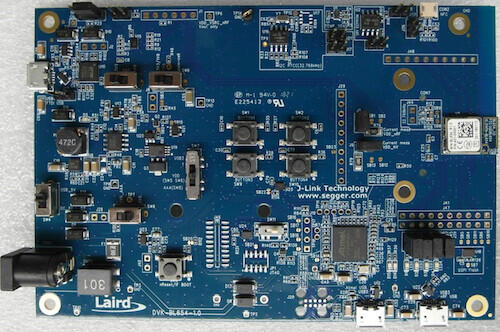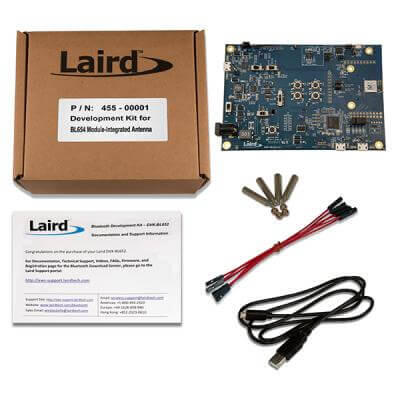Ezurio BL654 DVK
Overview
The BL654 Development Kit hardware provides support for the Ezurio BL654 module powered by a Nordic Semiconductor nRF52840 ARM Cortex-M4F CPU.
It is also pin compatible with the BL654PA which adds a power amplifier. The “pa” variant provides
this compatibility. Use board bl654_dvk/nrf52840/pa to build for that target.
Bluetooth LE regulatory certifications obtained by Ezurio are not applicable to BL654PA variant.
It should not be used in commercial applications prior to re-certification being performed - please review with the Ezurio team at www.ezurio.com/contact
This development kit has the following features:
ADC
CLOCK
FLASH
GPIO
I2C
MPU
NVIC
PWM
RADIO (Bluetooth Low Energy and 802.15.4)
RTC
Segger RTT (RTT Console)
SPI
UART
USB
WDT

BL654 Development Kit Board

455-00001 (BL654 DVK integrated antenna) Box Contents
More information about the board can be found at the BL654 website [1].
Hardware
Supported Features
The BL654 DVK board configuration supports the following hardware features:
Interface |
Controller |
Driver/Component |
|---|---|---|
ADC |
on-chip |
adc |
CLOCK |
on-chip |
clock_control |
FLASH |
on-chip |
flash |
GPIO |
on-chip |
gpio |
I2C(M) |
on-chip |
i2c |
MPU |
on-chip |
arch/arm |
NVIC |
on-chip |
arch/arm |
PWM |
on-chip |
pwm |
RADIO |
on-chip |
Bluetooth, ieee802154 |
RTC |
on-chip |
system clock |
RTT |
Segger |
console |
SPI(M/S) |
on-chip |
spi |
UART |
on-chip |
serial |
USB |
on-chip |
usb |
WDT |
on-chip |
watchdog |
Other hardware features have not been enabled yet for this board. See BL654 website [1] for a complete list of BL654 Development Kit board hardware features.
Connections and IOs
LED
LED1 (blue) = P0.13
LED2 (blue) = P0.14
LED3 (blue) = P0.15
LED4 (blue) = P0.16
Programming and Debugging
Applications for the bl654_dvk board configuration can be built, flashed,
and debugged in the usual way. See Building an Application and
Run an Application for more details on building and running.
Flashing
Follow the instructions in the Nordic nRF5x Segger J-Link page to install and configure all the necessary software. Further information can be found in Flashing. Then build and flash applications as usual (see Building an Application and Run an Application for more details).
Here is an example for the Hello World application.
First, run your favorite terminal program to listen for output.
NOTE: On the BL654 DVK, the FTDI USB should be used to access the UART console.
$ minicom -D <tty_device> -b 115200
Replace <tty_device> with the port where the board nRF52 DK
can be found. For example, under Linux, /dev/ttyUSB0.
Then build and flash the application in the usual way.
# From the root of the zephyr repository
west build -b bl654_dvk samples/hello_world
west flash
Debugging
Refer to the Nordic nRF5x Segger J-Link page to learn about debugging Nordic based boards with a Segger IC.
Testing Bluetooth on the BL654 DVK
Many of the Bluetooth examples will work on the BL654 DVK. Try them out: